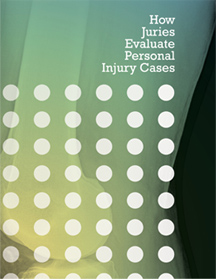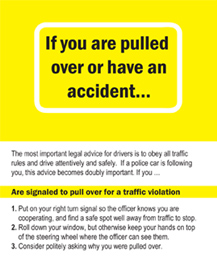Valuation of minor injury cases
For the purposes of this article, a “minor injury claim” is defined as one involving some degree of injury to the body, but that does not result in lasting or permanent injury and that, after the healing process, does not prevent the injured person from resuming all pre-injury activities. The factors considered by insurance companies include:
Type of injury
The insurance carrier considers the nature of the injuries claimed by reviewing information obtained from medical records, medical reports and similar documents. In addition, the carrier identifies the likely areas of disagreement, e.g., extent of injury (particularly injuries that only manifest pain and discomfort), and whether the injury existed before the accident. Carriers often claim the injury was not a direct result of an accident, but rather merely an aggravation of a pre-existing injury.
Subjective vs. objective injuries
Frequently, carriers dispute the very existence of nonobservable injuries. These include the sprains, strains, and other musculoligamentous injuries (“soft tissue injuries”) commonly suffered in automobile accidents. When the injury’s existence in not questioned, the carrier will often attempt to minimize the injury or its effect. Observable injuries, also known as objective injuries, are injuries that can be observed on x-rays or through other physically verifiable means, and are more readily accepted by adjusters than “subjective injuries.” Nevertheless, the carrier may still attempt to minimize their effect.
In claims involving primarily or entirely subjective injuries, the plaintiff or claimant must be prepared to demonstrate that the injury indeed exists by referring to its results, for example, the inability to work or conduct normal activities, reliance on others for assistance, cancelled engagements and a general change of lifestyle compatible with a decreased physical capacity. The plaintiff must focus on the results because a carrier will probably take the position the injury doesn’t exist at all, or at least, that the injury is minimal and transitory.
Medical treatment rendered
Musculoligamentous injuries often require little active medical treatment, and frequently a regimen of rest, heat, and analgesics. Adjusters point to the lack of concentrated medical treatment in such cases as their “proof” that in fact there really was no injury. Treatments of these injuries through physical therapy are sometimes labeled “build-ups,” meaning the claimant purposely undergoes unneeded medical treatment in order to incur unwarranted medical expense, knowing a settlement offer will be, in part at least, a function of medical bills incurred.
Diagnostic vs. treating medical
Adjusters usually do not question the need for what they term as a “treating medical” expense as opposed to a “diagnostic medical” expense. Adjusters separate diagnostic medical expenses, giving less weight to such expenses during the evaluation process than “treating medical” expenses. In doing so, adjusters sometimes fail to appreciate that musculoligamentous injuries sometimes require extensive diagnostic evaluations to rule out the possibility that the pain complained of does not stem from a cause other than a mere strain or sprain.
Location of treatment
During the evaluation process, the adjuster notes where the medical treatment took place. The usual course of treatment in a “soft tissue” injury is an examination conducted by a physician in the physician’s office or in a hospital emergency room, followed by self treatment at home consisting of rest, analgesics, and heat. The adjuster more readily recognizes the gravity and extent of the injury if the initial medical examination takes place in the hospital emergency room, and if any part of the treatment is rendered in a physical therapy center or hospital. Hospitalization, even if only for observation purposes, is generally convincing evidence to adjusters that there actually was an injury, and that the injury was significant.
Duration of treatment
How long did the claimant undergo medical treatment? Significant injuries require longer periods of medical treatment than do minor ones. It follows, therefore, that the longer the duration of treatment, the greater the value of the claim. The reasoning here is difficult to dispute, but the conclusions drawn are sometimes invalid, particularly in situations where the duration of treatment is used as an index to the severity of the injuries. The same index is used to illustrate overtreatment or “build-up.”
Medical expense
The cost of medical expenses is probably the single most important consideration in the claim evaluation process. As an index to case value, it leaves much to be desired for compensation purposes because medical expense fails to illustrate the degree of pain, suffering, and inconvenience experienced by the claimant during the claimant’s period of recovery. This becomes particularly true in cases involving injuries that simply heal themselves for which little medical intervention is possible.
Loss of earnings
This is a valid consideration during the evaluation process as it represents an actual out-of-pocket cost to the claimant that, but for the accident, clearly would not have been incurred. An adjuster will probably differentiate between “gross loss of earnings” and “net loss of earnings,” deducting from the gross loss those amounts the claimant will not have to pay as a result of the loss (usually income tax and social security premiums). The adjuster commonly deducts a flat twenty percent from any amount of lost earnings submitted to him.
Other expenses
A claimant is entitled to recover in settlement all other necessary out-of-pocket expenses incurred as a result of the accident. The more frequently encountered expenses, such as rental vehicles to replace the claimant’s damaged automobile, child care, household help, and similar items, are usually acceptable to the adjuster unless the amounts and necessity for such expenses need verification. If no receipts are readily available for these payments, the adjuster may claim a “lack of documentation” and thus refuse to reimburse them. Adjusters often question the validity of household services performed by family members (e.g., claimant paid his sister to come over and make dinner for claimant’s benefit), as well as the validity of any receipts provided as proof of such payments.
General damages
The amount of general damages (compensation for pain and suffering) will vary widely depending on the adjuster’s perception and determination of the validity and necessity of the aforementioned factors. After considering the factors involved in the liability situation by using the formula “value equals damages times liability,” the sum total of the special damages (economic losses such as medical expenses and lose income) accepted by the adjuster and the adjuster’s evaluation of appropriate general damages yields the settlement offer. Thus, a case valued by the insurance company at $5,000, but in which the adjuster believes the claimant was 25% at fault, will yield a net settlement offer of $3,750.
Liability
The adjuster carefully considers any applicable defenses that the carrier has in opposition to the claimant’s claims. In doing so, the adjuster doubtlessly interprets factors involving fault in the insured’s favor in much the same way as the claimant often minimizes or denies any suggestion that the claimant was in any way at fault. Of all the factors considered by the adjuster during the evaluation process, none assumes greater importance than liability, and none occupies more of the adjuster’s time. An insurance company adage is “don’t try cases on damages, try them on liability.” This adage is disregarded about as often as it is respected, but the attitude remains.
To illustrate, a salesman, 35, earning a salary of $750 per week, is involved in an intersection accident in which both sides claim the other ran a red light. The salesman’s physician examines the salesman, who complains of severe neck pain. Cost of the examination, including x-rays, is $225. The diagnosis is strain and sprain of the cervical area. Treatment recommended is plenty of rest, moist heat, pain medication, and re-examination in one week. Initially, the salesman is unable to care for himself, and he needs his wife to help him dress, eat and perform other daily functions. After a week, still complaining of severe pain, he returns to his physician, who refers him to a neurologist to determine whether to rule out neurological injuries. The physician’s examination costs $150, the neurologist charges $250. As it turns out, the neurologist’s examination is negative. The original diagnosis of strain and sprain of the cervical area having been confirmed, the treating physician prescribes a period of physical therapy. The salesman undergoes therapy three times per week for four weeks at a cost of $35 per session. Six weeks after the accident, the physician re-examines the salesman and releases him from treatment. The final examination cost is $150.
The insurance company and the plaintiff each use some of the more common evaluation techniques.
The insurance company will have little to argue about regarding the special damages, but will deduct 20% from the six weeks loss of earnings for taxes. Thus, each side views the special damages involved as follows:
| Insurance Company | Plaintiff | |
| Medical expense: | $1,195 | |
| Lost earnings: (6 weeks at $750) | +4,500 | |
| $5,695 |
The insurance company uses two different methods for its evaluation of the claim. In the first, it uses the salesman’s weekly earnings as an index to general damages, and calculates $750 x 6 $4,500 + special damages = $9,295. In the second method, it calculates ten times medical specials to arrive at general damages, then adds in the loss of earnings to achieve $1,195 x 10 = $11,950 + $3,600 = $15,555.
The plaintiff evaluates the case at three times the specials, using the carrier’s figure of loss of earnings less 20%, and concludes that $4,795 X 3 = $14,385. Plaintiff then calculates at three times the specials using full value for the loss of earnings and concludes that $5,695 x 3 = $17,085. Thus, the claim is evaluated as follows:
| Insurance Company | |
| $9,295 to $15,555 | $14,385 to $17,085 |
Since the two evaluations overlap, settlement appears likely, although liability must also be calculated. In the instant case, the accident was an intersection accident in which both parties claim the other ran a red light. If the two factual recollections of the accident cannot be resolved through witnesses or physical evidence, both sides must carefully weigh the chances that their side of the story will be believed by a trier of fact. The insurance carrier takes the position that the case is one of 50-50 liability, and adjusts its settlement offer accordingly. Accordingly, the range placed upon the claim by the carrier becomes $4,647 to $7,775.
The plaintiff is willing to concede, for the purposes of settlement, that he may have a problem with proof, and would thus agree to a 25% reduction in settlement. Therefore, the plaintiff’s value becomes $10,789 to $12,813.
The two evaluations no longer overlap. One side or the other or both will have to alter its position in order to achieve a settlement.



